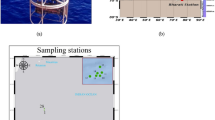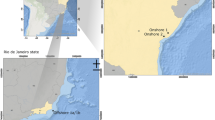Abstract
Incomplete removal of sodium dodecyl sulfate (SDS) in wastewater treatment plants may result in SDS residues escaping and finding their way into receiving water bodies like rivers, lakes, and sea. Introduction of effective microorganisms into the aerobic treatment facilities can reduce unpleasant by-products and SDS residues. Selecting effective microorganisms for SDS treatment is a big challenge. Current study reports the isolation, identification, and in situ monitoring of an effective SDS-degrading isolate from detergent-polluted river waters. Screening was carried out by the conventional enrichment culture technique and the isolate was tentatively identified by using fatty acid methyl ester and 16S ribosomal RNA (rRNA) sequence analyses. Fatty acids produced by the isolate investigated were assumed as typical for the genus Comamonas. 16S rRNA sequence analysis also confirmed that the isolate had 95 % homology with Delftia acidovorans known as Comamonas or Pseudomonas acidovorans previously. D. acidovorans exhibited optimum growth at SDS concentration of 1 g l-1 but tolerated up to 10 g l-1 SDS. 87 % of 1.0 g l-1 pure SDS was degraded after 11 days of incubation. The temporal succession of D. acidovorans in detergent-polluted river water was also monitored in situ by using Comamonas-specific fluorescein-labeled Cte probe. Being able to degrade SDS and populate in SDS-polluted surface waters, D. acidovorans isolates seem to be very helpful in elimination of SDS.





Similar content being viewed by others
References
Abboud MM, Khleifat KM, Batarseh M, Tarawneh KA, Al-Mustafa A, Al-Madadhah M (2007) Different optimization conditions required for enhancing the biodegradation of linear alkyl benzosulfonate and sodium dodecyl sulfate surfactants by novel consortium of Acinetobacter calcoaceticus and Pantoea agglomerans. Enzym Microb Technol 41:432–439
Adac A, Bandyopadhyay M, Pal A (2005) Removal of anionic surfactant from wastewater by alumina a case study. Physicochem Eng 254:165–171
Amann RI (1995) In situ identification of microorganisms by whole cell hybridization with rRNA-targeted nucleic acid probes. In: Akkerman ADL, van Elsas JD, de Brujin FJ (eds) Molecular microbial ecology manual. Kluwer Academic, Dordrecht, pp 1–15
Amann RI, Binder BJ, Olson RJ, Chisholm SW, Devereux R, Stahl DA (1990) Combination of 16S rRNA-targeted oligonucleotide probes with flow cytometry for analyzing mixed microbial populations. Appl Environ Microbiol 56:1919–1925
Baudart J, Olaizola A, Coallier J, Gauthier V, Laurent P (2005) Assessment of a new technique combining a viability test, whole-cell hybridization and laser-scanning cytometry for the direct counting of viable Enterobacteriaceae cells in drinking water. FEMS Microbiol Lett 243:405–409
Benson DA, Karsch-Mizrachi I, Lipman DJ, Ostell J, Rapp BA, Wheeler DL (2002) GenBank. Nucleic Acids Res 30:17–20
Bryukhanov AL, Korneeva VA, Kanapatskii TA, Zakharova EE, Men’ko EV, Rusanov II, Pimenov NV (2011) Investigation of the sulphate-reducing bacterial community in the aerobic water and chemocline zone of the Black Sea by the FISH Technique. Microbiology 80:112–120
Chang YH, Han JI, Chun J, Lee KC, Rhee MS, Kim YB, Bae KS (2002) Comamonas koreensis sp. nov., a non-motile species from wetland in Woopo, Korea. Int J Syst Evol Microbiol 52:377–381
Chen HJ, Tseng DH, Huang SL (2005) Biodegradation of octylphenol polyethoxylate surfactant Triton X-100 by selected microorganisms. Bioresour Technol 96:1483–1491
Chou JH, Sheu SY, Lin KY, Chen WM, Arun AB, Young CC (2007) Comamonas odontotermitis sp. nov., isolated from the gut of the termite Odontotermes formosanus. Int J Syst Evol Microbiol 57:887–891
Daims H, Brühl A, Amann R, Schleifer KH, Wagner M (1999) The domain-specific probe EUB338 is insufficient for the detection of all bacteria: development and evaluation of a more comprehensive probe set. Syst Appl Microbiol 22:434–444
Devereux R, Kane MD, Winfrey J, Stahl DA (1992) Genus- and group-specific hybridization probes for determinative and environmental studies of sulfate-reducing bacteria. Syst Appl Microbiol 15:601–609
Devereux R, Mundfrom GW (1994) A phylogenetic tree of 16S rRNA sequences from sulfate-reducing bacteria in a sandy marine sediment. Appl Environ Microbiol 60:3437–3439
Dhouib A, Hamad N, Hassaïri I, Sayadi S (2003) Degradation of anionic surfactants by Citrobacter braakii. Process Biochem 38:1245–1250
Fendinger NJ, Versteg DJ, Weeg E, Dyer S, Rapaport RA (1994) Environmental behavior and fate of anionic surfactants. In: Baker LA (ed) Environmental chemistry of lakes and reservoirs. ACS Advances in Chemistry Series No. 237. Washington, DC: American Chemical Society
Fernández E, Benito JM, Pazos C, Coca J (2005) Ceramic membrane ultrafiltration of anionic and non-ionic surfactant solutions. J Membr Sci 246:1–6
Frostegard AE, Bafiafith E, Tunlid A (1993) Shifts in the structure of soil microbial communities in limed forests as revealed by phospholipids fatty acid analysis. Soil Biol Biochem 25:723–730
Goldberg S, Konis Y, Rosenberg M (1990) Effect of cetylpyridinium chloride on microbial adhesion to hexadecane and polystyrene. Appl Environ Microbiol 56:1678–1682
Haack SK, Garchow K, Odelson DA, Forney LJ, Klug MJ (1994) Accuracy, reproducibility and interpretation of fatty acid methyl ester profiles of model bacterial communities. Appl Environ Microbiol 60:2483–2493
Hosseini F, Amirmozafari N, Malekzadeh F, Ghaemi N (2007) Biodegradation of anionic surfactants by isolated bacteria from activated sludge. Int J Environ Sci Technol 4:127–132
Icgen B, Harrison STL (2006a) Exposure to sulphide causes populations shifts in sulphate-reducing consortia. Res Microbiol 157:784–791
Icgen B, Harrison STL (2006b) Identification of population dynamics in sulphate-reducing consortia on exposure to sulphate by 16S rRNA probing. Res Microbiol 157:922–927
Icgen B, Moosa S, Harrison STL (2007) A study of the relative dominance of selected anaerobic sulphate-reducing bacteria in a continuous bioreactor by fluorescence in situ hybridization. Microb Ecol 53:43–52
Jurado E, Fernández-Serrano M, Nunez-Olea J, Luzon G, Lechuga M (2006) Simplified spectrophotometric method using methylene blue for determining anionic surfactants: Applications to the study of primary biodegradation in aerobic screening tests. Chemosphere 65:278–285
Khleifat KM (2006) Biodegradation of linear alkylbenzene sulfonate by a two-member facultative anaerobic bacterial consortium. Enzyme Microb Technol 39:1030–1035
Lane DJ, Pace B, Olsen GJ, Stahl DA, Sogin ML, Pace NR (1985) Rapid determination of 16S ribosomal RNA sequences for phylogenetic analyses. Proc Natl Acad Sci U S A 82:6955–6959
Li B, Irvin S, Baker B (2007) The variation of nitrifying bacterial population sizes in a sequencing batch reactor (SBR) treating low/mid/high concentrated wastewater. J Environ Eng Sci 6:651–663
Liwarska E, Bizukojc M (2006) Effect of selected anionic surfactants on activated sludge flocs. Enzyme Microb Technol 33:1–9
Loy A, Horn M, Wagner M (2003) probeBase-an online resource for rRNA targeted oligonucleotide probes. Nucleic Acids Res 31:514–516
Marchesi JR, Owen SA, White GF, House WA, Russell NJ (1994) SDS-degrading bacteria attach to riverine sediment in response to the surfactant or its primary biodegradation product dodecan-1-ol. Microbiology 140:2999–3006
Martinez JF, Munoz MG (2007) Evaluation of the sensitivity of three cladoceran species widely distributed in Mexico to three reference toxicants. J Environ Sci Heal 42:1417–1424
Massol-Deya AA, Whallon J, Hickey RF, Tiedje JM (1995) Channel structures in aerobic bio films of fixed-film reactors treating contaminated groundwater. Appl Environ Microbiol 61:769–777
Morozova D, Zettlitzer M, Daniela Let D, Würdemann H, CO2SINK group (2011) Monitoring of the microbial community composition in deep subsurface saline aquifers during CO2 storage in Ketzin, Germany. Energy Procedia 4:4362–4370
Mozia S, Tomaszewska M, Morawski AW (2005) Decomposition of nonionic surfactant in a labyrinth flow photoreactor with immobilized TiO2 bed. Appl Catal Environ 59:155–160
Paisley R (2004) Training manual MIS whole cell fatty acid analysis by gas chromatography. MIDI, Newark
Rabus R, Fukui M, Wilkes H, Widdel F (1996) Degradative capacities and 16S rRNA-targeted whole cell hybridization of sulfate-reducing bacteria in an anaerobic enrichment culture utilizing alkylbenzenes from crude oil. Appl Environ Microbiol 62:3605–3613
Ramsing NB, Kühl M, Jörgensen BB (1993) Distribution of sulfate-reducing bacteria, O2 and H2S in photosynthetic biofilms determined by oligonucleotide probes and microelectrodes. Appl Environ Microbiol 59:3820–3849
Rao CS (1995) Environmental pollution control engineering. Wiley Eastern Ltd., p 301
Sacchi CT, Whitney AM, Mayer LW, Morey R, Steigerwalt A, Boras A, Weyant RS, Popovic T (2002) Sequencing of 16S rRNA gene: a rapid tool for identification of Bacillus anthracis. Emerg Infect Dis 8:1117–1123
Schleheck D, Tindall BJ, Rossell-Mora R, Cook AM (2004) Parvibaculum lavamentivorans gen. nov., spec. nov., a new heterotrophic bacterium which initiates catabolism of linear alkylbenzenesulfonate (LAS). Int J Syst Evol Microbiol 54:1489–1497
Schleifer KH, Amann RI, Ludwig W, Rothemund C, Springer N, Dorn S (1992) Nucleic acid probes for the identification and in situ detection of Pseudomonads. In: Galli E, Silver S, Withold B (eds) Pseudomonas: molecular and biology biotechnology. Washington American Society of Microbiology, Washington, DC, pp 127–134
Scott MJ, Jones MN (2000) The biodegradation of surfactants in the environment. Biochim Biophys Acta 1508:235–251
Shigematsu T, Yumihara K, Ueda Y, Numaguchi M, Morimura S, Kida K (2003) Delftia tsuruhatensis sp. nov., a terephthalate-assimilating bacterium isolated from activated sludge. Int J Syst Evol Microbiol 53:1479–1483
Shukor MY, Husin WSW, Rahman MFA, Shamaan NA, Syed MA (2009) Isolation and characterization of an SDS-degrading Klebsiella oxytoca. J Environ Biol 30:129–134
Singh KL, Kumar A, Kumar A (1998) Bacillus cereus capable of degrading SDS shows growth with a variety of detergents. World J Microbiol Biotechnol 14:777–779
Spiegelman D, Whissell G, Greer CW (2005) A survey of the methods for the characterization of microbial consortia and communities. Can J Microbiol 51:355–386
Tago Y, Yokota A (2004) Comamonas badia sp. nov., a flocforming bacterium isolated from activated sludge. J Gen Appl Microbiol 50:243–248
Talens-Alesson FI, Hall ST, Hankins NP, Azzopardi BJ (2002) Flocculation of SDS micelles with Fe3+. Colloids Surf 204:85–91
Tan SC, Yiap BC (2009) DNA, RNA and protein extraction: the past and the present. J Biomed Biotechnol 2009:1–10
van Ginkel CG (1996) Complete degradation of xenobiotic surfactants by consortia of aerobic organisms. Biodegradation 7:151–164
Wagner M, Erhart R, Manz W, Amann R, Lemmer H, Wedi D, Schleifer KH (1994) Development of an rRNA-targeted oligonucleotide probe specific for the genus Acinetobacter and its application for in situ monitoring win activated sludge. Appl Environ Microbiol 60:792–800
Wallner G, Amann R, Beisker W (1993) Optimizing fluorescent in situ hybridization with rRNA-targeted oligonucleotide probes for flow cytometric identification of microorganisms. Cytometry 14:136–143
Wauters G, De Baere T, Willems A, Falsen E, Vaneechoutte M (2003) Description of Comamonas aquatica comb. nov. and Comamonas kerstersii sp. nov. for two subgroups of Comamonas terrigena and emended description of Comamonas terrigena. Int J Syst Evol Microbiol 53:859–862
Ying GG (2006) Fate, behavior and effects of surfactants and their degradation products in the environment. Environ Int 32:417–431
Zhang T, Oyama T, Horikoshi S, Zhao J, Serpone N, Hidaka H (2003) Photocatalytic decomposition of the sodium dodecylbenzene sulfonate surfactant in aqueous titania suspensions exposed to highly concentrated solar radiation and effects of additives. Appl Environ 42:13–24
Author information
Authors and Affiliations
Corresponding author
Additional information
Responsible editor: Robert Duran
Rights and permissions
About this article
Cite this article
Yilmaz, F., Icgen, B. Characterization of SDS-degrading Delftia acidovorans and in situ monitoring of its temporal succession in SDS-contaminated surface waters. Environ Sci Pollut Res 21, 7413–7424 (2014). https://doi.org/10.1007/s11356-014-2653-x
Received:
Accepted:
Published:
Issue Date:
DOI: https://doi.org/10.1007/s11356-014-2653-x




